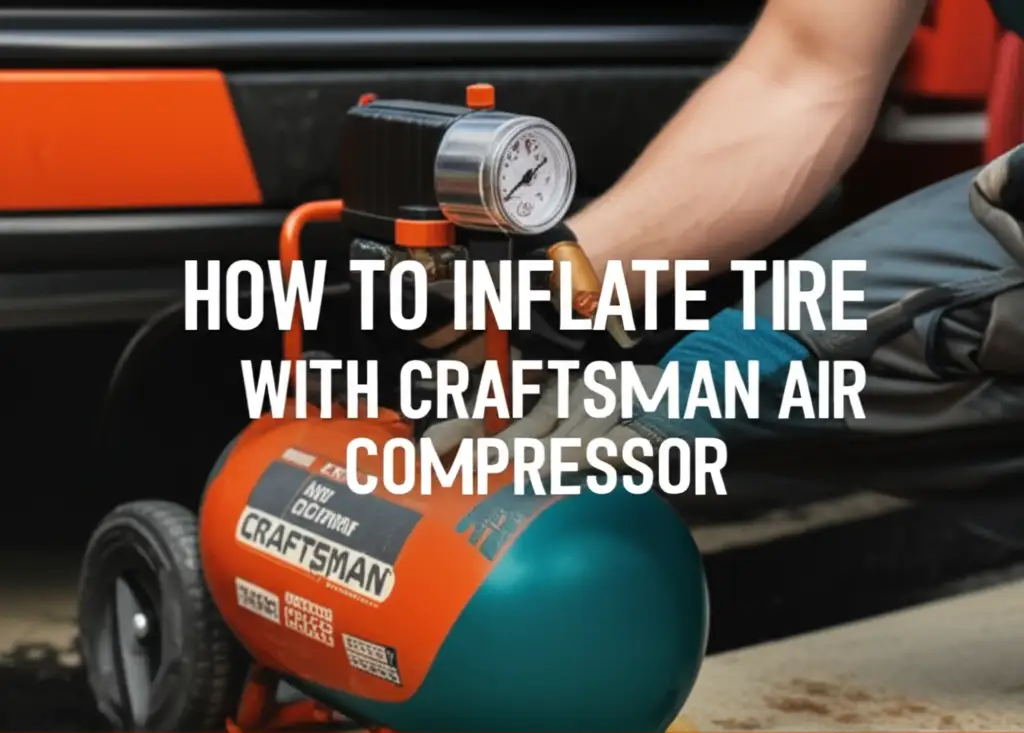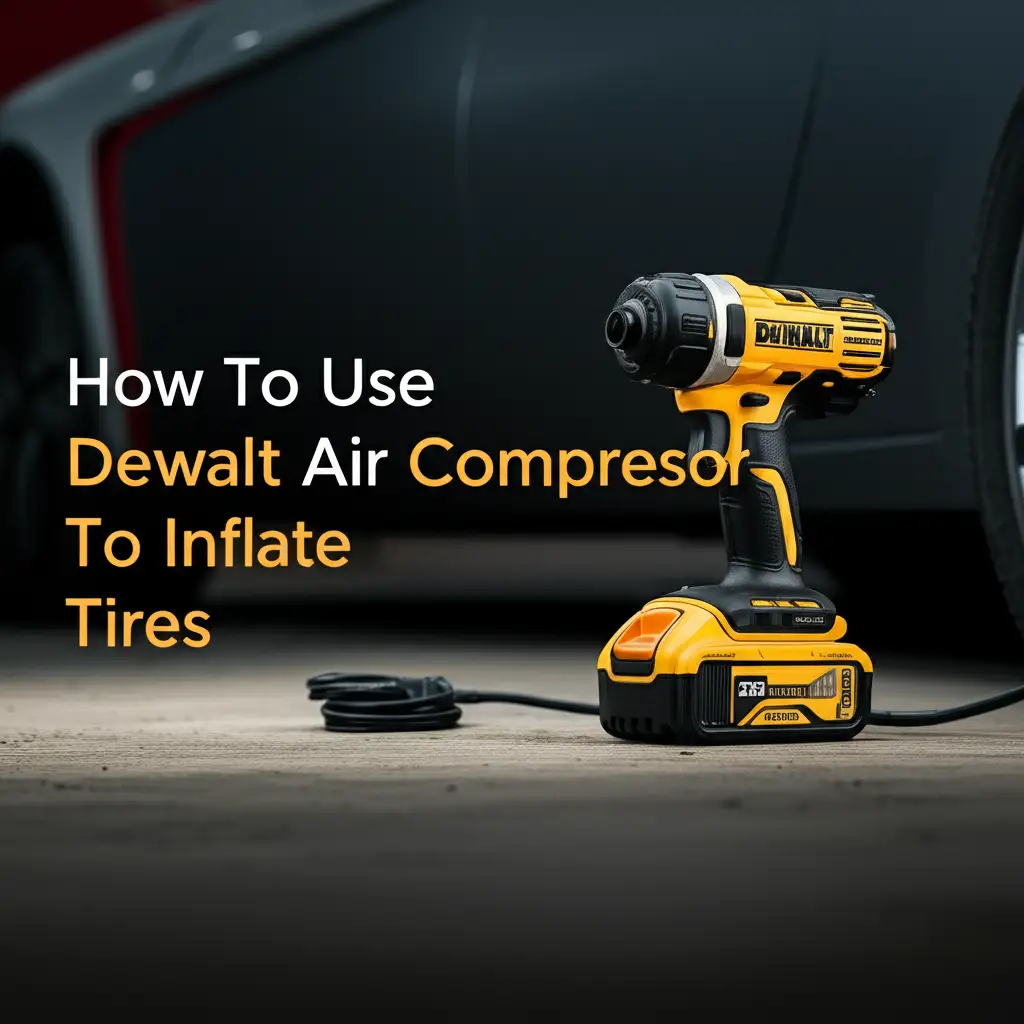· Todd Martin · Tool Guides · 14 min read
How To Inflate Tire With Craftsman Air Compressor

How To Inflate Tire With Craftsman Air Compressor
Having correctly inflated tires is important for vehicle safety. It also helps with fuel efficiency. Many people wonder how to inflate tire with Craftsman air compressor models. This guide shows you how to use your Craftsman air compressor to keep your tires at the right pressure. We will cover the basic steps from setup to maintenance. You will learn about safety, proper connection, and how to read tire pressure accurately. My goal is to make tire inflation simple and straightforward for you. This article equips you with the knowledge to handle tire inflation confidently.
Takeaway
To inflate a tire with your Craftsman air compressor:
- Ensure the compressor is on a stable, level surface.
- Connect the air hose and appropriate chuck to the compressor.
- Check the tire’s recommended PSI on the sidewall or vehicle sticker.
- Attach the chuck to the tire valve stem.
- Add air in short bursts, checking pressure frequently with a reliable gauge.
- Disconnect the chuck when the correct PSI is reached.
- Drain the compressor tank after use to prevent rust.
You inflate a tire with a Craftsman air compressor by connecting the air hose, attaching a tire chuck to the valve stem, and slowly adding compressed air while monitoring the pressure with a gauge. Ensure the compressor is stable and powered on, and always check the tire’s recommended PSI before starting.
Understanding Your Craftsman Air Compressor
Craftsman air compressors are powerful tools. They compress air and store it in a tank. This stored air helps power various pneumatic tools. You can also use it for tasks like tire inflation. Understanding its basic parts makes operation safer and easier.
Your compressor has key components. The motor drives the pump. The pump takes in air and pushes it into the tank. A pressure gauge shows the air pressure inside the tank. The regulator controls the air pressure output for your tools. An air hose connects to an outlet on the compressor. The hose then connects to the tire valve using a chuck.
Safety is always the top priority when using an air compressor. Compressed air can be dangerous if not handled properly. Always read your Craftsman owner’s manual before starting any task. Never point the air nozzle at yourself or others. Ensure you wear proper eye protection during operation. This protects your eyes from debris or sudden bursts of air.
Proper maintenance also ensures your compressor works well. Regularly check for air leaks. Listen for unusual noises during operation. Make sure the compressor is in good working order. A well-maintained compressor operates safely and efficiently for years. If you find your compressor isn’t building pressure, you might need to troubleshoot some issues. Why Won’t My Craftsman Air Compressor Build Pressure offers some solutions.
Gathering Essential Tools and Safety Gear
Before you inflate any tire, gather all necessary tools. Having everything ready saves time and ensures a smooth process. You will need certain items to complete the job safely and effectively. This preparation step is crucial for success.
First, you need your Craftsman air compressor. Ensure it is in good working order and powered on. Second, an air hose with a universal chuck is essential. Most compressors come with these items. If not, purchase a durable air hose and a chuck that fits tire valve stems. Some chucks have built-in gauges, which are convenient.
Next, a reliable tire pressure gauge is a must-have. Even if your chuck has a gauge, an independent gauge gives more accurate readings. Digital gauges are easy to read. Pencil-style gauges are also effective. Always check the gauge’s accuracy periodically. An inaccurate gauge leads to improper tire pressure.
Safety gear protects you from potential hazards. Eye protection, such as safety glasses, shields your eyes from dust or debris. Gloves can protect your hands while working with equipment. You should also wear closed-toe shoes to protect your feet. These simple precautions prevent accidents.
Lastly, have your vehicle’s owner’s manual nearby. This manual contains the recommended tire pressure for your specific vehicle. You can often find this information on a sticker inside the driver’s side door jamb or in the glove compartment. Knowing the correct PSI is vital for optimal performance and safety. Having all these items ready before you start makes the process much simpler.
Preparing Your Craftsman Compressor for Tire Inflation
Preparing your Craftsman air compressor is a straightforward process. Correct setup ensures safe and efficient operation. This step also prevents potential damage to your equipment or tires. I always make sure these steps are done carefully.
First, place your compressor on a stable, level surface. This prevents it from tipping over during operation. Ensure there is good airflow around the unit. Do not operate it in an enclosed space. Connect the compressor to a suitable power outlet. Use an extension cord that handles the compressor’s power requirements if needed. Overloaded circuits can cause issues, and your compressor might trip a breaker. If this happens, check out Why Does My Craftsman Air Compressor Keeps Tripping Breaker for help.
Next, attach the air hose to the compressor’s air outlet. Many compressors use a quick-connect fitting for the hose. Pull back the collar on the fitting, push the hose end in, and release the collar. Ensure it clicks into place. This creates a secure, leak-free connection. Attach the tire chuck to the other end of the air hose.
Before inflating, ensure the compressor builds enough pressure. Turn on the compressor and let it run until it reaches its maximum cut-off pressure. This is usually indicated on the tank pressure gauge. Adjust the regulator to the desired output pressure. For tires, you typically want to set the regulator higher than the target PSI, as the tire will only take what it needs. However, for accuracy, it’s safer to add air in short bursts and check frequently with an external gauge.
Finally, check the drain valve. If you have not used the compressor in a while, there might be moisture in the tank. Drain any accumulated condensation from the tank. This prevents rust inside the tank and extends the compressor’s life. Some older models might need a drain valve replacement. Learn more at How To Replace Drain Valve On Craftsman Air Compressor.
Connecting and Inflating Vehicle Tires
Inflating vehicle tires with a Craftsman air compressor is a common and important task. Proper technique ensures you achieve the correct pressure. Follow these steps carefully to inflate your tires safely and effectively. I always take my time with this part.
Start by removing the valve stem cap from the tire you plan to inflate. Store the cap in a safe place so you do not lose it. The valve stem is where the air goes in and out of the tire. It is a small, usually black, rubber or metal stem sticking out from the wheel.
Next, firmly attach the tire chuck to the valve stem. You will hear a hiss of air as you connect it. This hiss means the chuck is properly seated. If the chuck has a lever, push or pull it to lock the chuck onto the valve stem. A good connection prevents air from escaping while you are inflating. Make sure the chuck is straight on the stem.
Once the chuck is attached, begin adding air in short bursts. Press the trigger on the chuck to release air from the compressor into the tire. Do not hold the trigger down continuously. Instead, use short, controlled bursts. This method prevents over-inflation and allows you to check the pressure easily. After each burst, release the trigger and quickly check the tire pressure with your separate tire gauge. Always remove the chuck to get an accurate reading with your manual gauge.
Compare the current pressure to your vehicle’s recommended PSI. This is found on a sticker inside the driver’s door jamb or in your owner’s manual. Continue adding air in short bursts until you reach the target pressure. If you over-inflate the tire, you can release air by pressing the small pin inside the valve stem with the back of your tire gauge or a small tool. When the tire reaches the correct pressure, remove the chuck and replace the valve stem cap. This process is similar to using any portable air compressor. For general tips, you can refer to How To Use Portable Air Compressor To Inflate Tires.
Inflating Other Items: Bicycles, Sports Equipment, and More
Your Craftsman air compressor is not just for vehicle tires. It is a versatile tool for many inflation needs. You can use it for bicycle tires, sports balls, and even inflatables. Different items require different adapters and pressure settings.
For bicycle tires, you usually need a Presta valve adapter if your bike uses Presta valves instead of Schrader valves (the common car tire type). Most Craftsman compressor kits include various adapters. Attach the correct adapter to your air chuck. Bicycle tires generally require higher PSI than car tires but have much smaller air volumes. Inflate slowly and check the pressure often with a bicycle-specific gauge, as car gauges might not be accurate for high bicycle pressures.
Sports equipment like basketballs, footballs, or soccer balls require a needle adapter. This small, thin adapter screws onto your air chuck. Insert the needle into the ball’s inflation port. These items need much lower pressure than tires, typically 7-12 PSI. Inflate very slowly and check frequently to avoid over-inflating and damaging the ball. You can feel the ball’s firmness to help gauge the pressure.
For inflatable toys, air mattresses, or pools, you will need a larger nozzle adapter. These adapters are wider and allow for faster inflation of large volumes. These items do not require high pressure; you inflate them until they are firm but not hard. Over-inflation can cause ruptures. Always check the item’s recommended inflation instructions.
Always adjust your compressor’s regulator to a lower output pressure when inflating these smaller, lower-pressure items. This gives you better control and prevents accidental over-inflation. Using a suitable adapter and carefully monitoring pressure is key. My Craftsman compressor has saved me many trips to the gas station for these smaller tasks. Remember to check the specific PSI requirements for each item you inflate.
Checking and Adjusting Tire Pressure Accurately
Maintaining proper tire pressure is vital. It impacts vehicle safety, handling, and fuel efficiency. Checking and adjusting tire pressure accurately is a simple but important task. I make this part of my regular car maintenance routine.
First, always check tire pressure when tires are cold. “Cold” means the vehicle has been parked for at least three hours or has been driven less than a mile. Driving heats up tires, which increases internal air pressure. A hot tire reading will be inaccurate. This is a common mistake people make.
Locate your vehicle’s recommended tire pressure. This information is typically on a sticker inside the driver’s side door jamb. It might also be in your owner’s manual or on the glove compartment door. This sticker lists the PSI (pounds per square inch) for both front and rear tires, and sometimes the spare. Never use the “max pressure” listed on the tire’s sidewall. That is the maximum pressure the tire can hold, not the recommended operating pressure for your vehicle.
Use a reliable tire pressure gauge. I prefer a digital gauge for its clear display. Remove the valve stem cap from the tire. Press the gauge firmly onto the valve stem until the hissing sound stops and the gauge shows a reading. Read the pressure. If it is too low, add air in short bursts using your Craftsman air compressor, as described earlier. Recheck the pressure after each burst.
If the pressure is too high, gently press the small pin inside the valve stem to release air. Do this in small increments and recheck the pressure. Continue adjusting until the tire matches the recommended PSI. Always double-check your readings. Repeat this process for all four tires and the spare if applicable. Proper tire pressure helps your tires last longer and keeps your vehicle performing at its best.
Post-Inflation Procedures and Compressor Maintenance
After you finish inflating your tires, proper shutdown and maintenance procedures are important. These steps ensure your Craftsman air compressor remains in excellent condition. Good habits prolong the life of your tool. I always do these steps immediately after using my compressor.
First, disconnect the air hose from the tire valve stem. Replace the valve stem caps on all inflated tires. Disconnect the air hose from the compressor. Release any remaining air pressure in the hose. You can usually do this by pressing the chuck trigger or a quick-release button on the hose.
Next, turn off your Craftsman air compressor. Unplug it from the power outlet. This prevents accidental startup and saves electricity. Store the power cord neatly. Coil the air hose to prevent kinks and tangles. A well-organized setup is easier to use next time.
One critical maintenance step is draining the air tank. Moisture from the air accumulates in the tank as condensation. If left, this water can cause rust inside the tank, leading to damage. Most compressors have a drain valve, usually at the bottom of the tank. Place a container under the drain valve. Open the valve slowly to release the water and air. You will hear air escaping, followed by water. Close the valve once all water is out and only air escapes. Performing this after every use, or at least regularly, prevents rust. For detailed instructions on cleaning your compressor tank, you can check out How To Clean Air Compressor Tank.
Finally, store your compressor in a clean, dry area. Protect it from dust and extreme temperatures. If your compressor is oil-lubricated, check the oil level periodically. Replace the oil according to the manufacturer’s recommendations. Knowing What Kind of Oil Does My Craftsman Air Compressor Use is key for its longevity. Regular maintenance ensures your Craftsman air compressor is always ready for its next task.
FAQ Section
What PSI should I inflate my car tires to?
You should inflate your car tires to the PSI recommended by your vehicle manufacturer. This information is typically found on a sticker inside the driver’s side door jamb, in the owner’s manual, or sometimes on the glove compartment door. Do not use the maximum pressure listed on the tire sidewall.
Can I use my Craftsman air compressor for other items besides car tires?
Yes, you can use your Craftsman air compressor for many other items. These include bicycle tires, sports balls, and various inflatables. You will need the correct adapters, such as a Presta valve adapter for bicycles or a needle adapter for sports balls. Always check the specific pressure requirements for each item.
How often should I check my tire pressure?
You should check your tire pressure at least once a month. It is also good practice to check pressure before long trips. Remember to check tires when they are cold, meaning the vehicle has been parked for a few hours or driven for a very short distance.
What should I do if I over-inflate my tire?
If you over-inflate your tire, you can release air by gently pressing the small metal pin located inside the tire valve stem. You can use the back of your tire pressure gauge or a small, pointed tool for this. Release air in small bursts and recheck the pressure frequently until it reaches the recommended PSI.
Is it important to drain the water from my air compressor tank?
Yes, it is very important to drain water from your air compressor tank regularly. Moisture from the air condenses inside the tank during operation. If this water is not drained, it can lead to rust and corrosion inside the tank, damaging the compressor and potentially compromising its safety and performance over time.
Conclusion
Inflating tires with your Craftsman air compressor is a straightforward process. It is a valuable skill for any vehicle owner. You now understand how to set up your compressor, connect to tires, and inflate them safely. Remember to always check the recommended PSI for your tires. Proper tire pressure improves fuel efficiency, enhances vehicle handling, and extends tire life.
Regular use of your Craftsman air compressor for tire maintenance saves you time and money. It also provides peace of mind knowing your vehicle is safe on the road. Always prioritize safety by wearing protective eyewear and following proper procedures. Take care of your compressor through regular draining and proper storage. You can maintain perfect tire pressure and ensure your compressor lasts for many years to come.
- Craftsman air compressor
- tire inflation
- air compressor use
- tire pressure
- vehicle maintenance
- DIY car care
- tool safety
- compressed air
- tire repair





